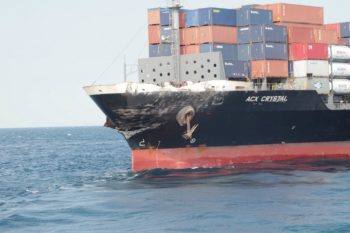
The United States Coast Guard on Tuesday started interviewing the crew of a Philippines-flagged container ship which collided with a U.S. warship in Japanese waters killing seven American sailors.
The U.S. coast guard investigation is one of several into the incident on Saturday involving the guided missile destroyer USS Fitzgerald and the much larger ACX Crystal. The cause of the collision at night and in clear weather is not known.
“We are scheduled to interview the crew members,” said U.S. Lieutenant Scott Carr, referring the crew of the merchant ship. The USS Fitzgerald crew will also be interviewed.
The U.S. coast guard, which is undertaking the investigation on behalf of the U.S. National Transportation Safety Board, will gather electronic data and ship tracking information from the USS Fitzgerald and ACX Crystal.
The investigation will also look into a time discrepancy in the ACX Crystal’s initial report of the incident south of Tokyo Bay, said Scott.
“There is a contradiction. It will be part of the investigation,” Carr said.
The Japan Coast Guard has already spoken to the Filipino crew and is also probing the inconsistency. It is in talks with the U.S. Navy for access to its crew members and data from the destroyer, a spokesman for the organization said.
The U.S. Navy did not immediately respond when asked if it would release tracking data to the Japan Coast Guard.
The ACX Crystal reported the collision at 2:25 a.m. (1725 GMT) prompting Japanese authorities to initially log the incident at 2:20 a.m.
The Japan Coast Guard subsequently revised the time to 1:30 a.m. meaning the container ship waited 55 minutes before contacting the coast guard, according to the Japan Coast Guard.
The merchant ship, chartered by Japan’s Nippon Yusen KK, made a complete U-turn between 12:58 a.m. and 2:46 a.m. on June 17.
The Fitzgerald did not contact local authorities. The Japan Coast Guard radioed it after receiving the first report of the collision.
Many of the crew on the U.S. ship were asleep when the collision tore a gash under the waterline on the warship’s starboard side, flooding two crew compartments, the radio room and the auxiliary machine room.
When asked on Sunday if the damage indicated the U.S. ship could have been at fault, Seventh Fleet commander Vice Admiral Joseph P. Aucoin declined to speculate on the cause.
Complicating the inquiries could be issues of jurisdiction. Although the collision occurred in Japanese waters, international maritime rules, could allow the U.S. Navy to claim some authority over the investigations.
The incident was the greatest loss of life on a U.S. Navy vessel since the USS Cole was bombed in Yemen’s Aden harbor in 2000, when 17 sailors were killed and 39 injured.